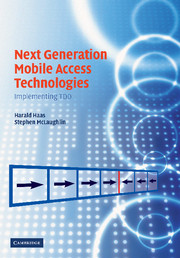Book contents
- Frontmatter
- Contents
- List of abbreviations
- Acknowledgements
- 1 Introduction
- 2 Wireless telecommunications using CDMA and TDD techniques
- 3 Interference and capacity analyses
- 4 Centralised DCA algorithm using the TS-opposing idea
- 5 Distributed DCA algorithm utilising the TS-opposing idea
- 6 UTRA-TDD Opportunity-Driven Multiple Access (ODMA)
- 7 Routing strategies in multi-hop CDMA networks
- 8 Multi-hop DCA
- 9 Radio resource metric estimation
- 10 Interference-based cancellation techniques for TDD
- 11 Smart Antennas for TDD-CDMA Systems
- 12 Cellular OFDMA-TDD
- 1 Derivation of T: Unconstrained Optimisation
- Bibliography
- Index
5 - Distributed DCA algorithm utilising the TS-opposing idea
Published online by Cambridge University Press: 02 September 2009
- Frontmatter
- Contents
- List of abbreviations
- Acknowledgements
- 1 Introduction
- 2 Wireless telecommunications using CDMA and TDD techniques
- 3 Interference and capacity analyses
- 4 Centralised DCA algorithm using the TS-opposing idea
- 5 Distributed DCA algorithm utilising the TS-opposing idea
- 6 UTRA-TDD Opportunity-Driven Multiple Access (ODMA)
- 7 Routing strategies in multi-hop CDMA networks
- 8 Multi-hop DCA
- 9 Radio resource metric estimation
- 10 Interference-based cancellation techniques for TDD
- 11 Smart Antennas for TDD-CDMA Systems
- 12 Cellular OFDMA-TDD
- 1 Derivation of T: Unconstrained Optimisation
- Bibliography
- Index
Summary
Introduction
In this chapter a distributed dynamic channel assignment (DCA) algorithm applicable for the TDD mode of the UMTS terrestrial radio access (UTRA) is presented. It is closely related to the DCA used in the DECT (digitally enhanced cordless telecommunications) system (Punt et al., 1998). Once again, the discovery made in Chapter 3 is exploited; that is, that for certain scenarios opposed synchronisation of TSs between neighbouring cells is advantageous. The new distributed DCA algorithm is supported by the results of the investigation in section 4.2. In this section it was demonstrated that synchronous transmission and reception between neighbouring cells may not yield the greatest capacity that is attainable in a single cell. It was found, however, that when the centralised DCA algorithm developed in section 4.3 was applied to multiple cells it was not feasible to fully exploit the potential gains revealed by the capacity analysis of a single cell.
In this chapter it is demonstrated that by applying the novel distributed DCA algorithm, which utilises the TS-opposing idea, greater capacity can result than would be obtained by synchronous transmissions. Most importantly, this is shown to be valid for a TDMA-CDMA/TDD (TD-CDMA/TDD) network, which accounts for full spatial coverage. Channel asymmetry is assumed to be arranged by code pooling rather than TS pooling (3GPP, TSG, RAN, 2000c).
- Type
- Chapter
- Information
- Next Generation Mobile Access TechnologiesImplementing TDD, pp. 135 - 156Publisher: Cambridge University PressPrint publication year: 2008

